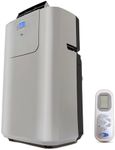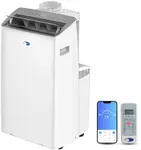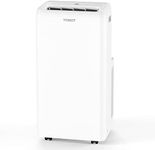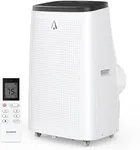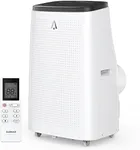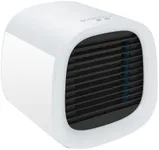Buying Guide for the Best Tower Air Conditioner
Choosing the right tower air conditioner can significantly improve your comfort during hot weather. Tower air conditioners are designed to be compact and portable, making them ideal for small spaces or rooms where traditional air conditioning units are not feasible. When selecting a tower air conditioner, it's important to consider several key specifications to ensure you get the best fit for your needs. Understanding these specifications will help you make an informed decision and find a unit that provides efficient cooling, is easy to use, and fits your space and lifestyle.Cooling CapacityCooling capacity, measured in BTUs (British Thermal Units), indicates how much heat the air conditioner can remove from a room per hour. This is a crucial spec because it determines the effectiveness of the unit in cooling your space. For small rooms (up to 150 square feet), a unit with 5,000-6,000 BTUs is sufficient. Medium-sized rooms (150-300 square feet) typically require 7,000-10,000 BTUs, while larger rooms (300-500 square feet) may need 10,000-14,000 BTUs. To pick the right cooling capacity, consider the size of the room you want to cool and choose a unit that matches or slightly exceeds the required BTUs for optimal performance.
Energy EfficiencyEnergy efficiency is measured by the Energy Efficiency Ratio (EER), which is the ratio of the cooling capacity to the power input. A higher EER means the unit is more efficient and will consume less electricity, saving you money on energy bills. EER ratings typically range from 8 to 12. For better energy savings, look for units with an EER of 10 or higher. If you plan to use the air conditioner frequently, investing in a more energy-efficient model can be beneficial in the long run.
Noise LevelNoise level, measured in decibels (dB), indicates how loud the air conditioner will be when operating. This is important for ensuring a comfortable environment, especially if you plan to use the unit in a bedroom or living room. Noise levels can range from 40 dB (quiet) to 60 dB (moderate). For a quieter experience, look for units with noise levels below 50 dB. Consider where you will place the air conditioner and how sensitive you are to noise when choosing the right model.
Airflow and Fan SpeedsAirflow, measured in cubic feet per minute (CFM), indicates how much air the unit can circulate. Higher CFM means better air circulation and faster cooling. Fan speeds allow you to adjust the airflow to your preference. Most units offer multiple fan speeds, typically ranging from 2 to 4 settings. If you need quick cooling or want to customize the airflow, look for units with higher CFM and more fan speed options. Consider your cooling needs and how much control you want over the airflow when selecting a unit.
Additional FeaturesAdditional features can enhance the usability and convenience of the air conditioner. Common features include remote control, programmable timer, sleep mode, and oscillation. Remote control allows you to adjust settings from a distance, while a programmable timer lets you set the unit to turn on or off at specific times. Sleep mode adjusts the temperature for optimal comfort during sleep, and oscillation helps distribute cool air evenly throughout the room. Think about which features will make your experience more comfortable and convenient, and choose a unit that offers those options.
Size and PortabilitySize and portability are important for ensuring the air conditioner fits well in your space and can be moved easily if needed. Tower air conditioners are designed to be compact, but they vary in height and width. Check the dimensions to ensure the unit will fit in the intended location. Portability features like caster wheels and handles make it easier to move the unit from room to room. Consider the space you have available and whether you need to move the unit frequently when choosing the right size and portability features.




